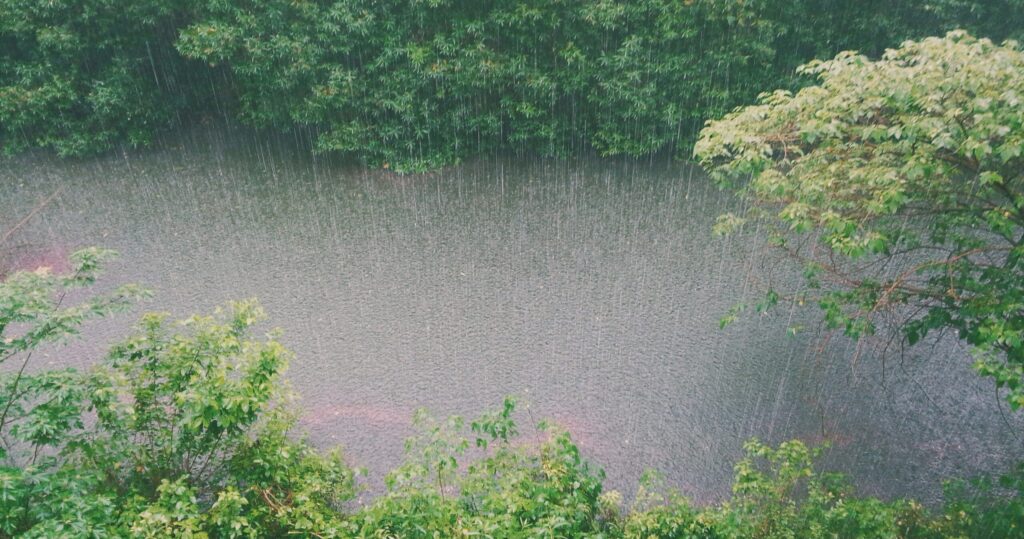On the subject of disastrous floods in Texas that claimed well over 100 lives, the first thing we’d like to see is more stories like “‘American Hero’: Coast Guard Swimmer Praised for Saving 165 From Flood at Camp Mystic”. Then we’d like to praise The Atlantic for a piece “The Texas-Flood Blame Game Is a Distraction/ Hastily assigning responsibility comes at the risk of oversimplifying the way natural disasters work.” And not just because the headline was responsible. The piece itself points to long-ago flooding in the same area and debunks claims that Donald Trump’s efforts to reduce bureaucracy killed kids. Unfortunately the kind of journalists who read The Atlantic apparently don’t read The Atlantic because for the most part they went right on babbling offensive nonsense, including the new herd-of-independent-minds fixation on this mysterious “attribution science” where just because you can’t responsibly say a given event was linked to climate change, you can say it.
A classic example being David Gelles in the New York Times “Climate Forward” writing:
“It’s too early to say with certainty that the slow-moving thunderstorms were made worse by man-made climate change. But the weather pattern that unleashed more than 10 inches of rain in a matter of hours is precisely the kind of phenomenon that scientists say is becoming more common because of global warming.”
So it’s too early, and grotesque. Watch us do it anyway. Even worse was the ever-present Frederike Otto (h/t Roger Pielke Jr):
“[G]iven the huge amount of scientific evidence on the link between fossil fuel-driven warming and rainfall, we don’t need to wait for an attribution study – extreme downpours like these are exactly what science expects in a rapidly warming world.”
Not that holding off for a rapid foregone conclusion would be too much to ask, but still, why wait? The Canadian Press was also quick off the mark with “Is Canada ready for ‘new reality’ of flash floods?”, a video described thusly:
“A climate change expert says Canada isn't doing enough to prevent tragedies similar to the flash flooding that hit Texas, where the death toll has surpassed 100. Ryan Ness of the Canadian Climate Institute says climate change is making flash flooding worse, and the country needs to invest in flood mapping, infrastructure and early warning systems.”
But are there more flash floods in Canada? Or does it no longer matter? Especially since Roger Pielke Jr. draws attention to the curious paradox that while the IPCC says extreme precipitation does seem to have increased significantly in some places, it does not say flooding has increased.
So all that stuff about “precisely the kind of phenomenon that scientists say is becoming more common because of global warming” is precisely bunk. Yes, some say rain has become more intense. But as RPJ points out, statistically there has been no increase in flash flooding in Texas in the last 20 years. And, he says with the appropriate qualifier “some” instead of the standard media implied “all”:
“Some climate scientists and journalists are promoting misinformation by claiming that flooding has increased because of increasing extreme precipitation”.
Which is ghoulish when exploiting a tragedy.
Leaving aside the truly ghastly people who online made comments about how it served white Christian kids right to get drowned in their nasty Christian white camps, in favour of the coast guard swimmer whose response to being called a “hero” was “The real heroes, I think, were the kids on the ground; those guys are heroic,” we do want to note that much of the other coverage had at least a hint of Schadenfreude especially out of place when getting key facts wrong.
The New York Times, for instance, sent out a “The Week in Climate” email that led off with:
“Trump Is Gutting Weather Science and Reducing Disaster Response”.
And the story in question said:
“As a warming planet delivers more extreme weather, experts warn that the Trump administration is dismantling the government’s disaster capabilities.”
Those wacky experts again. But the next item was:
“FEMA Didn’t Answer Thousands of Calls From Flood Survivors, Documents Show”
Which rather suggests that its disaster capabilities were nothing to phone about anyway. Ah, but of course it’s Trump’s fault:
“Two days after deadly Texas floods, the agency struggled to answer calls from survivors because of call center contracts that weren’t extended.”
A serious accusation. So what’s the source? They checked, right, including how many of these non-renewed contracts were due to the current administration, in office just six months? Um no. You guessed it. It was one disgruntled anonym:
“according to a person briefed on the matter who spoke on the condition of anonymity in order to discuss internal matters.”
And another thing. According to the Washington Post, the camp did get a timely warning, but took time to assess the situation that turned out to be disastrous:
“Camp Mystic’s leader got a ‘life threatening’ flood alert. They evacuated an hour later.”
And the leader himself was killed trying to rescue campers, so his error of judgement was not one of callousness.
Heatmap also went after that old standby, Orange Man Bad, anyway:
“The Only Weather Models That Nailed the Texas Floods Are on Trump’s Chopping Block/ Predicting the location and severity of thunderstorms is at the cutting edge of weather science. Now funding for that science is at risk.”
Boo Trump! But on the chopping block and already chopped aren’t the same, so what they’re claiming is that the very brilliant stuff that didn’t help this time may not be there to help next time. Also at time of initial drafting of this item, admittedly in Canada, we were threatened 24 hours ago with thunderstorms that same evening, and that evening when the skies remained clear with rain predicted all day the next day, when instead not a drop fell. So the “cutting edge of weather science” appears a bit blunt.
Moreover despite The Atlantic debunking such claims, that “Climate Forward” item even included:
“Part of the problem may have stemmed from staffing shortages at weather offices in Texas, according to former National Weather Service employees who spoke to Christopher Flavelle. On the ground, that meant ‘the loss of experienced people who would typically have helped communicate with local authorities in the hours after flash flood warnings were issued overnight.’”
But they were not short-staffed. As Heatmap also observed:
“Though it’s tempting to blame the Trump administration cuts to the staff and budget of the NWS for the tragedy, the local NWS actually had more forecasters on hand than usual in its local field office ahead of the storm, in anticipation of potential disaster. Any budget cuts to the NWS, while potentially disastrous, would not go into effect until fiscal year 2026.”
Maybe tempting to you and everybody you know. Not to other people.
Nor would it have mattered since, as the “Climate Forward” piece also conceded:
“Another contributing factor may have been the lack of a flash flood warning system along the banks of the Guadalupe River. Officials considered installing such a system eight years ago, but ultimately decided against it, The Times reported.”
And it linked to a Scientific American article that… rubbished Trump:
“Texas knows it isn't prepared for floods. But the state has done little to address the risk – and the federal government under President Donald Trump is unlikely to help Texas cover the cost.”
And it blamed climate change although you can’t because you can anyway:
“the latest disaster isn’t the first time Texas has dealt with mass casualties from a flood event. Nor is the upcoming Statehouse session the first time that Texas has tried to address flood risk. The lack of meaningful progress highlights the challenge of preparing for natural disasters such as floods and wildfires that are being made worse by climate change. And it reinforces the risk of shifting more of that responsibility to states, as proposed by the Trump administration.”
Thus giving Trump a second shot. And of course stinking red state conservatives generally:
“The lack of funding can be attributed to two factors, observers say. The first is ideological. Texas Republicans – who control the Statehouse and governor’s mansion – are big believers in fiscal conservatism. So there isn’t a groundswell of enthusiasm to fund major government projects.”
Observers say.
By the way The Economist gets some credit here for a piece deploring the “blame game” partly because, they note, “the winding strip of land that runs through central Texas is known as ‘flash-flood alley’” so any short-term explanation misses a big part of the picture. It also suggested that a related problem is that people there get so many weather warnings they tend to tune them out.
The other problem “Climate Forward” conceded was “practical” rather than “ideological”, the latter being a term that describes ideas other people hold even after you tell them yours. But in this case the practical one wasn’t very impressive:
“Before lawmakers were willing to commit money to flood projects, they wanted to make sure that plans were written to address each river basin in the state. Otherwise, there’s the risk that a project in one city would simply steer floodwaters to other communities, said state Sen. Charles Perry, who chairs the Senate Committee on Water, Agriculture and Rural Affairs.”
How installing flood-warning sirens might send the waters to someone else’s camp was not clarified in the piece, and it sounds feeble. Rather than exploring it, the article went back to rubbishing Trump and doing attribution science:
“The risks will keep rising with global warming, scientists say. That means events like last week’s floods will become more frequent.”
Scientists say. But are such floods becoming more frequent, or is it just one of those everybody-I-know-knows things? We’ve already shown you the answer.
To give “Climate Forward” some credit, it made the scientific claim that:
“Daniel Swain, a climate scientist at the University of California, said the research showed that as the planet warmed, sudden outbursts of extreme precipitation were becoming more powerful. In data that goes back to 1910, nine of the top 10 extreme one-day precipitation events have occurred since 1995, according to the Environmental Protection Agency.”
(For some reason the independent minds at Scientific Alarmism also interviewed… Daniel Swain.) But there is a problem with the EPA item the Times cited Swain citing, apart from the lack of connection to floods. It’s that the EPA chart actually shows a flatline from 1910 to 1990, then a jump upward to another flatline. Almost as if better measurement were creating an artefact. As a matter of fact, if you started in 1995, after the jump, you’d think there was a downward trend, and quite a sharp one since 2007. If you thought.
Also, as the EPA concedes:
“Weather monitoring stations tend to be closer together in the eastern and central states than in the western states. In areas with fewer monitoring stations, heavy precipitation indicators are less likely to reflect local conditions accurately.”
So do we really trust stats from, say, Wyoming from 1943?
P.S. The Conversation, which not infrequently attracts our ire, did the sort of thing we need more of in the press in the form of an article from a professor of civil and environmental engineering at UT San Antonio called “The Geology of Texas’ ‘Flash Flood Alley’ Explained” that actually talked about why the place has been prone to “heavy downpours and sudden, destructive floods” so long that it acquired its unsettling nickname.


